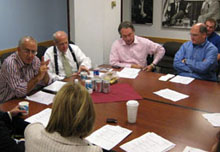Event
Polster Peter Hart: New, lapsed voters the ones to watch

October 1, 2008 — When it comes to interpreting public-opinion polls, Peter Hart knows a thing or two. After all, he’s been doing them for more than 40 years. “You have to have a strong stomach and very steady hands,” he says. Then there’s the recent poll he did that goes into uncharted territory, literally.
In his talk at the Shorenstein Center, titled “Where We Are,” Hart discussed a survey his firm did at the end of September for MySpace, NBC, and the Wall Street Journal. Jokingly introduced as a “pathological provocateur,” by Shorenstein Center director Alex S. Jones, Hart said he wanted to better understand the attitudes of new voters and those who hadn’t voted in 2004.
Such potential voters are thought to make up 10 to 13 percent of the electorate — around 15 million — and when an election is as hard-fought as this one, knowing what they think is crucial.
How did Hart reach them? “We went to the Internet. Of the 614 [people polled], essentially 500 were done by Internet, 100 by telephone,” he said. “This was a hard survey to do.”
The results are illuminating, he said, particularly in comparison to the 2004 election. In that contest, there was just an 8 percent split between Kerry and Bush among new or lapsed voters. This time, the gap is enormous: Obama has 61 percent and McCain 30 percent, with those undecided at just 9 percent. “If you have a 30-point differential, you’re talking about sizable numbers and important numbers,” he said.
Hart put a lot of emphasis on the survey group’s demographics, which he described as “fascinating”: 41 percent are non-caucasian, 35 percent have only cell phones, half are under the age of 25, and 57 percent say they’re Democratic. “The first thing you have to understand with these voters is that they’re unbelievably upset with the way things are going in America,” Hart said. But will they do more than just sound off in a poll? The answer seems to be yes: “71 percent said there were 9 or 10 [on a scale of 10] in terms of likely to vote.”
The poll was conducted the week that the financial crisis broke out, but Hart sees the results reflecting much broader, longer trends. “We’ve had 20-plus years where the American public said, ‘I want the government to do less.’ Since 2001, 2002, we have changed,” Hart said. “Essentially, we don’t trust any of the institutions to be able to serve us any more — we used to trust financial institutions, we used to trust corporations, we used to trust the media…. What’s happened with China, whether it’s toys or pharmaceuticals or food, [everything] builds upon that sense of distrust and that sense that it is government that has to be able to protect us. The financial is all part of that.” This reading is reflected in the poll: 72 percent of the participants said they wanted government to do more, not less.
While a lot of the numbers are good news for Obama and his supporters, there was one big caveat: independent voters were moving “in the wrong direction,” Hart said, and that could spell trouble. Overall, Hart cautioned against putting too much stock in day-to-day shifts, instead saying that there were only three numbers to watch:
1. Percentage of voters who identify as Republican or Democratic. “We have seen numbers this year in the plus-10 Democratic range. If the Democrats go in at 10, that’s a very important number. If closes up closer to 5 percent, throw away your betting cards.”
2. Perception that John McCain will continue the Bush agenda. “The most recent poll was about 58 percent. He needs to get that down to around 50 percent. If he doesn’t, that’s bad news for him.” (Hart later went on to correct the number: 61 percent of the new and lapsed voters felt that McCain would continue the Bush agenda.)
3. How much voters identify with candidates’ values and background. “If that’s in the neighborhood of 50 percent [for Obama], that’s a very good sign. If it’s down to 45 percent, that’s a bad sign.”
Hart concluded by saying, “If you watch those three numbers and throw out everything else, I guarantee you that by the time you get to Election Day, if those numbers are pointing in one direction, they’re going to tell you who’s going to win.”
This article was written by and the photos taken by Leighton Walter Kille of the Shorenstein Center.